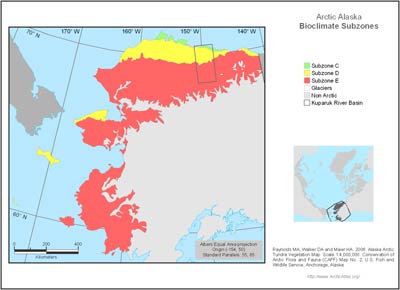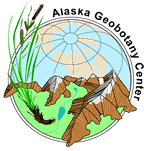Alaska Arctic Bioclimate Subzones
- AATVM
- Vegetation
- Bioclimate Subzones
- Floristic Provinces
- AVHRR
- Elevation
- Lake Cover
- Physiography
- NDVI and Phytomass
- Substrate Chemistry
- Literature

| Available data: | ||||
| |
GE |
Metadata |
GIS data |
GIS data |
The Arctic Tundra Bioclimate Zone is subdivided into five subzones (A-E). The southern three subzones occur in Alaska (C-E). As one goes from north to south, and farther from the ocean, summer temperatures increase, along with size, horizontal cover, abundance, productivity and variety of plants. Shrub height is a key distinguishing feature of each subzone. Only hemiprostrate and prostrate dwarf shrubs (‹15 cm tall) occur in Subzone C, along the northern coast of Alaska where mean July temperatures are about 5-7 °C. Erect dwarf shrubs (‹40 cm tall) occur in Subzone D where the mean July temperatures are about 7-9 °C. Low shrubs (40-200 cm tall) occur in Subzone E where mean July temperatures are about 9-12 °C. The southern boundary of Subzone E is treeline, where the mean July temperatures are about 10-12 °C and woody shrubs up to 2 m tall are abundant (Walker 2005).
See the Circumpolar Arctic Vegetation Map for a complete description of the bioclimate subzones:


